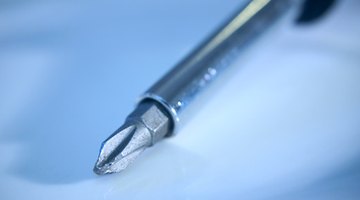How to Remove Medicine Cabinets
Removing a medicine cabinet is a fairly straightforward process. There may be complications if it is an older cabinet made from heavier materials, or if integrated lighting and electrical is involved.

Things You Will Need
- Drop cloth
- Plywood
- Screwdrivers
- Pliers
- Putty knife
- Electrical tape
Modern cabinets are made from lightweight materials that make removal easy for one person, and electrical concerns don’t create problems as long as appropriate care is taken. In many cases, removing one cabinet and installing a new one can be done quickly.
-
Place a drop cloth over the sink to protect the sink and drain from any debris that might fall while removing the cabinet. You can place a piece of plywood over the drop cloth to support the cabinet when you remove it.
-
Empty the cabinet’s contents and put them in a safe place. If there is an internal cabinet light, turn the power off to the bathroom circuit to allow you to safely remove the cabinet and disconnect the electrical connections.
-
Remove any internal cabinet fixtures like shelves or other attachments that could dislodge when removing the cabinet. Peel away any caulk that sealing the cabinet to the wall, using a putty knife.
-
Remove the screws holding the cabinet to the interior wall framing, using a screwdriver. Begin at the bottom of the cabinet. Take out screws from alternating sides while working your way upward. Place all the screws on the sink base so they will not roll off.
-
Pull the cabinet slightly away from the wall to access the wiring for any light inside the cabinet. Don’t remove the cabinet so far that it puts a strain on the wiring within the wall. Remove any electrical tape from the connection carefully. Twist off the wire nuts to separate the cabinet light’s wires from the house wires.
-
Remove the cabinet from the hole and place it on a sturdy surface, like the protected sink or the floor. Either replace the cabinet with a new one, or patch the hole in the wall. Collect all tools and materials from the cabinet removal and clean the work area to remove any dirt or debris.
Tip
If not replacing the cabinet or if replacing it with one without a light, wrap electrical tape over any exposed wires. Bend the wires back away from the cabinet opening and against a stud, where they will not make contact with anything metal. If the cabinet has a mirrored door, consider taking off the door so it will not break and cause injury while you're removing the cabinet.
Warning
Be certain that the electricity is turned off to the room if the cabinet you're removed has a built-in light.
References
- “Bathroom Remodeling for Dummies”; Gene Hamilton and Katie Hamilton; 2003
Tips
- If not replacing the cabinet or if replacing it with one without a light, wrap electrical tape over any exposed wires. Bend the wires back away from the cabinet opening and against a stud, where they will not make contact with anything metal.
- If the cabinet has a mirrored door, consider taking off the door so it will not break and cause injury while you're removing the cabinet.
Warnings
- Be certain that the electricity is turned off to the room if the cabinet you're removed has a built-in light.
Photo Credits
- screwdriver image by sheldon gardner from Fotolia.com
- screwdriver image by sheldon gardner from Fotolia.com
More Articles



